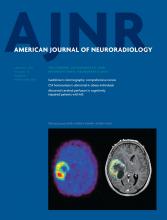Abstract
BACKGROUND AND PURPOSE: Detecting incidence and enlargement of lesions is essential in monitoring the progression of MS. In clinical trials, lesion load is observed by manually segmenting and comparing serial MR images, which is time consuming, costly, and prone to inter- and intraobserver variability. Subtracting images from consecutive time points nulls stable lesions, leaving only new lesion activity. We propose SuBLIME, an automated method for segmenting incident lesion voxels.
MATERIALS AND METHODS: We used logistic regression models incorporating multiple MR imaging sequences and subtraction images from consecutive longitudinal studies to estimate voxel-level probabilities of lesion incidence. We used T1-weighted, T2-weighted, FLAIR, and PD volumes from a total of 110 MR imaging studies from 10 subjects.
RESULTS: To assess the performance of the model, we assigned 5 subjects to a training set and the remaining 5 to a validation set. With SuBLIME, lesion incidence is detected and delineated in the validation set with an AUC of 99% (95% CI [97%, 100%]) at the voxel level.
CONCLUSIONS: This fully automated and computationally fast method allows sensitive and specific detection of lesion incidence that can be applied to large collections of images. Using the explicit form of the statistical model, SuBLIME can easily be adapted to cases when more or fewer imaging sequences are available.
ABBREVIATIONS:
- AUC
- area under ROC curve
- IQR
- interquartile range
- NAWM
- normal appearing white matter
- PD
- proton attenuation
- ROC
- receiver operating characteristic
- SuBLIME
- Subtraction-Based Logistic Inference for Modeling and Estimation
- © 2013 by American Journal of Neuroradiology
Indicates open access to non-subscribers at www.ajnr.org












